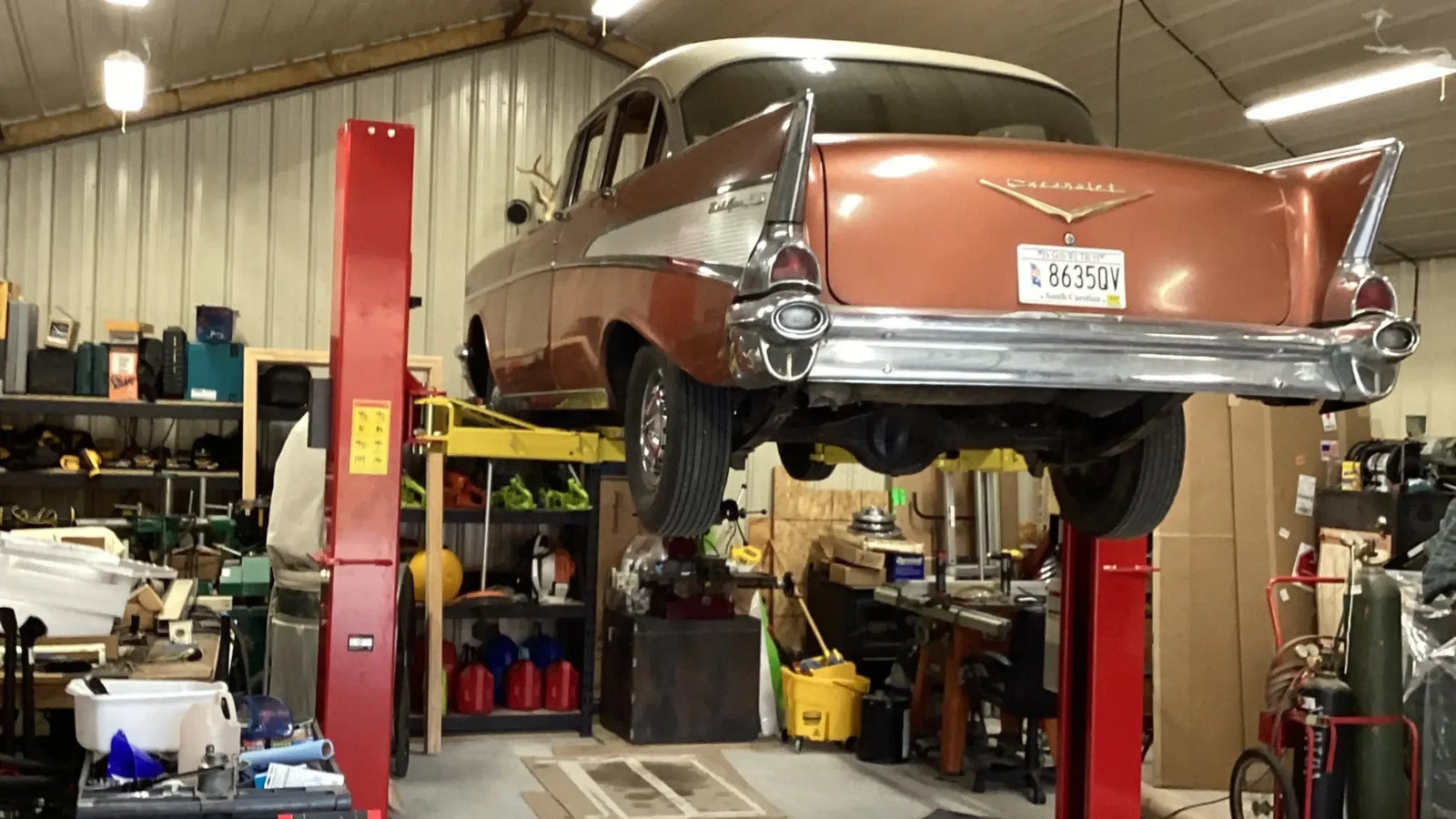
Regular maintenance keeps your 2 post lift safe and reliable. When did you last check it? Neglecting maintenance can cause breakdowns, expensive repairs, or safety issues. Learn two vital tips to maintain your lift well. Address your lift's issues before they worsen. These tips are a must-know for car lovers and mechanics alike. Maintenance doesn't have to be a drag. Simple tasks can prevent future problems. It's time to care for your 2 post lift properly. Maintenance doesn't have to be a drag. Simple tasks can prevent future problems. It's time to care for your 2 post lift properly.
Daily Lift Maintenance Tasks
Daily maintenance tasks help find issues before they get worse. Doing these tasks regularly keeps your 2 post lift safe and reliable.
Visual Inspection of Moving Parts
First, look at all moving parts closely. Check for damage, wear, or parts not lined up right. Focus on the lift's arms, base, and parts that lift the vehicles. Finding problems early helps avoid accidents and expensive fixes later.
Safety Lock and Hydraulic Connections
Make sure the lift's safety lock works well. It's key for keeping the lift steady and stopping the car from dropping unexpectedly. Look at the hydraulic connections for leaks or loose fittings. Fix any issues right away to keep the lift working properly.
Cable Inspection
Look at the lift's cables for damage like fraying or kinks. Damaged cables can lower the lift's ability to lift safely. Change any damaged cables fast to keep the lift safe to use.
Controls and Emergency Stop Test
Check if the lift's controls work well and respond as they should. Also, test the emergency stop button to make sure it stops the lift right away when used. Having controls and an emergency stop that work right is crucial for everyone's safety.
| Important Daily Lift Maintenance Tasks |
|---|
| Perform visual inspection of moving parts |
| Check the safety lock and hydraulic connections |
| Inspect the lift's cables |
| Test the controls and emergency stop |
Weekly Lift Maintenance Tasks
It's essential to perform weekly maintenance on your 2 post car lift. These routine checks help prevent small problems from getting big. They also keep you from spending a lot on repairs.
Cleaning and Lubrication
- Wipe down the entire lift to remove dust, debris, and any accumulated fluids that may affect its performance.
- Lubricate the rollers and pivot points using a suitable lubricant to ensure smooth movement and reduce wear and tear.
Inspections and Tightening
- Inspect the anchor bolts for any signs of damage or looseness. Tighten them if necessary to maintain stability and safety.
- Check the hydraulic oil level and top it up if needed. Proper hydraulic fluid levels are essential for the lift's operation.
- Tighten all bolts, nuts, and screws throughout the lift to ensure they are secure and minimize the risk of malfunction.
- Inspect the cables and lifting mechanisms for wear, fraying, or other signs of damage. Promptly address any issues to prevent accidents.
Keeping up with these weekly tasks is key to your lift's long life. By keeping it clean, well-lubricated, and tightly secured, breakdowns become rare. Plus, it ensures safety in your workspace.
Monthly Lift Maintenance Tasks

For your car lift to last long, it's key to check it closely every month. These maintenance steps help keep your lift working well. This prevents small problems from turning into big, expensive fixes.
- Lubricate columns, cables, and drive screws: Keeping these parts well-oiled cuts down on friction and wear. This makes your lift work smoothly. Always use the high-quality lubricants the maker suggests. This will make important parts last longer.
- Remove covers and clean out dirt build-up: Dirt and junk can get in the way of your lift's work. Take off the covers and clean away any dirt. Focus on places where dirt gathers, like the bottom of the columns.
- Verify the torque of bolts, safeties, and pivot pins: Every month, make sure bolts, safeties, and pivot pins are tight. If they're loose or not right, the lift could be unsafe. Use a torque wrench to check everything is as tight as the maker says.
- Check the length and tension of the cables: Cables might stretch or need adjusting with time. Make sure they are as long and as tight as they should be. Adjust them by following what the maker says. The right cable tension makes lifting safe and efficient.
Doing these monthly checks will keep your 2 post lift in great shape. Regular looking over, oiling, and fixing will cut down on breakdowns. It makes sure your lift is safe and reliable.
| Maintenance Task | Description |
|---|---|
| Lubricate columns, cables, and drive screws |
Adding oil to these parts helps them move without too much friction. This keeps the operation smooth. |
| Remove covers and clean out dirt build-up |
Getting rid of dirt and debris makes the lift work better and last longer. |
| Verify the torque of bolts, safeties, and pivot pins |
Making sure everything is tight keeps the lift stable and safe. |
| Check the length and tension of the cables |
Keeping cables at the right length and tension ensures safe lifting. |
Yearly Lift Maintenance Tasks

Doing yearly inspections and maintenance is key to keeping your lift working well. You need to check, fix, or switch out certain parts. This ensures your lift is safe and works right. Here are key yearly tasks for lift upkeep:
- Greasing Rub Blocks: Lubricate the rub blocks to cut down on friction and wear.
- Changing Hydraulic Fluid: Swap out the hydraulic fluid to keep the lift's hydraulics running smoothly.
- Replacing Hydraulic Hoses: Look at and swap any hydraulic hoses that are worn or damaged to prevent leaks and ensure smooth operation.
- Replacing Rollers: Check rollers for wear and replace them to keep lifting and lowering smooth.
- Replacing Cables: Look for any fraying or damage on the cables and replace them for safe lifting.
- Replacing Sheaves: Check sheaves for wear or bending and replace as needed for proper cable position.
- Checking Hydraulic and Air Cylinders: Check hydraulic and air cylinders for any harm or changes in shape. Fix issues to keep lifting safe and efficient.
Remember, these maintenance jobs might need a skilled professional. Consulting a 2 post lift maintenance expert ensures tasks are done right and meet manufacturer standards.
Keeping up with maintenance is key to your lift's long life and safety. With a full maintenance schedule and quick issue fixes, your lift stays in top shape. This lowers the chance of breakdowns or accidents.
| Yearly Lift Maintenance Tasks | |
|---|---|
| Greasing Rub Blocks |
Apply lubrication to reduce friction and wear. |
| Changing Hydraulic Fluid |
Replace hydraulic fluid for proper functioning. |
| Replacing Hydraulic Hoses |
Inspect and replace worn or damaged hoses. |
| Replacing Chains |
Check and replace worn or damaged chains. |
| Replacing Rollers |
Inspect and replace worn rollers. |
| Replacing Cables |
Check and replace frayed or damaged cables. |
| Replacing Sheaves |
Inspect and replace worn or deformed sheaves. |
| Checking Hydraulic and Air Cylinders |
Inspect for damage or deformations and address issues. |
Correct Vehicle Positioning and Arm Locking Mechanisms
It's vital to position your vehicle right for safety with a 2 post lift. Finding the center of gravity helps keep it balanced. Make sure to adjust the lifting arms so the weight spreads out evenly. This prevents accidents and damage.
It's also crucial to check the arm locking mechanisms. These mechanisms stop the arms from moving sideways while the vehicle is lifted or lowered. Regular checks ensure they work right and keep hazards away.
Always position vehicles correctly and keep an eye on the arm locks to boost your lift's safety. Always follow the lift maker's guide on how to do this for your lift. This makes sure you're doing everything safely.
2 Post Lift Safety Checklist:
- Identify the vehicle's center of gravity before lifting.
- Adjust the lifting arms to align with the vehicle's lifting points.
- Ensure the arm locking mechanisms are engaged and functioning properly.
- Never exceed the recommended weight capacity of the lift.
- Keep the lifting area clear of any obstructions.
- Verify that the lift's safety features, such as the safety locks and emergency stop, are in working order.
Using a detailed lift safety checklist helps prevent accidents. This includes proper vehicle positioning and checking the arm locks often. Doing so ensures a safe work area in your automotive place.
Conclusion
Keeping your auto lift in good shape is key to its safe and reliable use. By sticking to a detailed maintenance plan and doing regular checks, you can avoid sudden failures. This care not only keeps your lift working well but also makes lifting your vehicles safer.
Looking after your car lift involves tasks that need to happen daily, weekly, monthly, and yearly. Checking moving parts every day and safety locks helps spot early problems. Every week, make sure to oil the rollers and inspect the anchor bolts for a smoother lift function.
Each month, cleaning off dirt and looking over cables and pivot pins keeps the lift working right. Then, once a year, a trained professional should swap out the hydraulic fluid and change any parts that are wearing out.
By following these maintenance steps and quickly handling any problems, you can cut down on repair costs. This approach to upkeep is a wise investment in your 2 post lift. It ensures you can rely on it for many years without hassle.
FAQ
Why is regular maintenance important for a 2 post lift?
Regular maintenance keeps a 2 post lift working safely and reliably. It helps stop breakdowns and avoids high repair costs.
What are some daily maintenance tasks for a 2 post lift?
Daily tasks include checking all moving parts, the safety lock, and hydraulic connections. You should also check cables for damage and test the controls and emergency stop.
What should be done during weekly lift maintenance?
Weekly, clean the lift and lubricate moving parts like rollers. Check the anchor bolts and hydraulic oil level.
Tighten all bolts, nuts, and screws. Also, the cables and lifting mechanisms must be inspected closely.
What tasks should be included in monthly lift maintenance?
Monthly maintenance should cover lubricating columns, cables, and screws. Clean out any dirt build-up and check the torque of important parts.
Also, inspect the cables' length and tension and adjust them if needed.
What yearly maintenance tasks should be performed on a 2 post lift?
Yearly tasks include greasing rub blocks, changing hydraulic fluid, and replacing key parts like hoses and cables. It's also vital to inspect cylinders for any damage.
Why is vehicle positioning important for a 2 post lift?
Correct vehicle positioning ensures the lift's safety. It involves finding the vehicle's center of gravity and adjusting the lifting arms for balance.
How should arm locking mechanisms be checked?
Check arm locking mechanisms regularly to avoid arm movement. Make sure they are fully engaged before lifting for safety.


